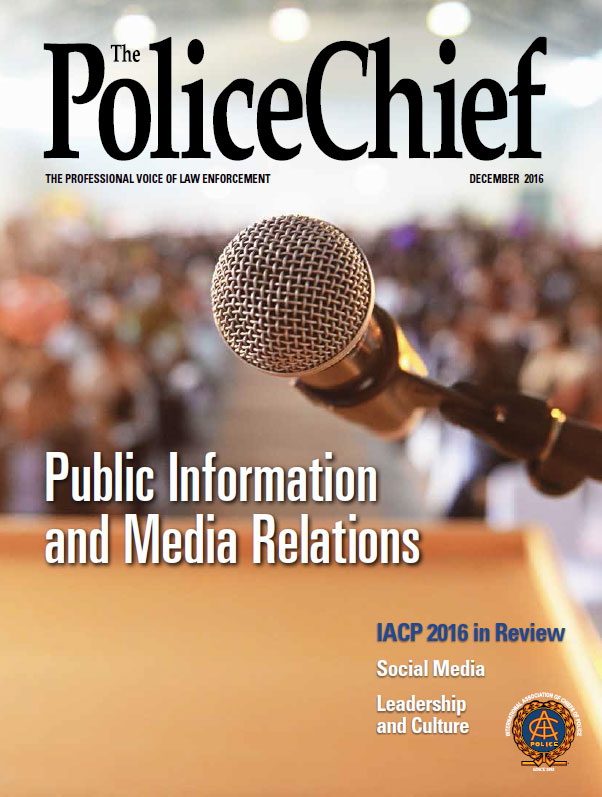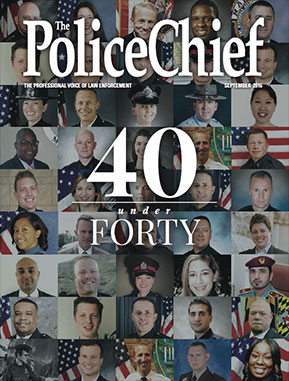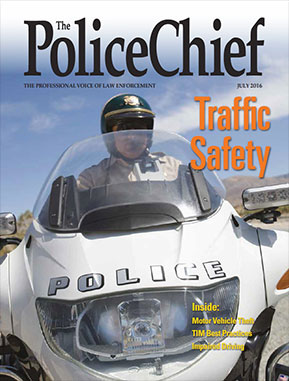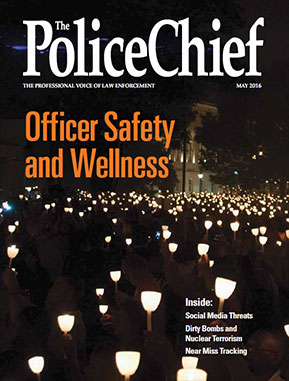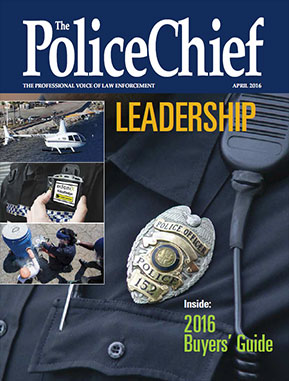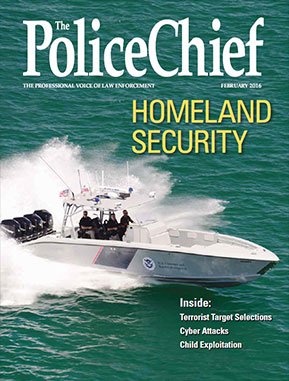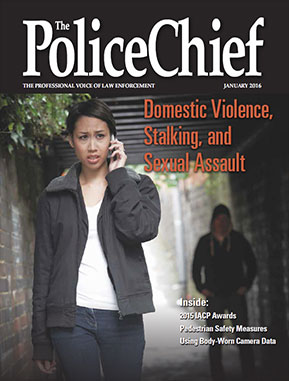Issue Archive
December 2016
Table of Contents
x
- From Handshakes to Hashtags: Using Every Communication Tool in the Law Enforcement Toolbox
- Bringing Social Media Strategy into the 21st Century
- Eliminate the Middleman: Telling the Agency’s Own Story with Social Media
- Retweets and Robert Peel: How to Take Community Policing Online with Twitter
- PIO “Jump Teams”: Cross-Jurisdictional Crisis Support
- Circle of Safety: Leadership’s Role in the Law Enforcement Environment
- Report of the 123rd Annual IACP Conference and Exposition
November 2016
Table of Contents
x
- The Education Panacea: Addressing Wide-Ranging Challenges with Advanced Education
- Learning the Art of Active Listening and Responding: An Ethical Imperative for Police Training
- Training Toward Law Enforcement-EMS Integration: New York State’s Efforts at the State Preparedness Training Center
- Integrated Policing Response for Abused Seniors: Learning in Action
- An EPIC Idea by NOPD: A New Model for Ethical Policing
- Physiological Effects on Police Officers Performing Field Trauma Medicine and Tourniquet Application
- Building Response Capacity for Distributed Attacks
October 2016
Table of Contents
x
- Cybersecurity: A Call to Action for Police Executives
- Biometric Identification Innovation: Iris Recognition
- Implementing Evidence-Based Practices
- Embracing the Cloud: How Third-Party Digital Evidence Can Make the Case
- Forensics and Biometrics: Emerging Technologies in Identity Operations
- Game Changer: The FBI’s RISC Mobile ID Query
- Overcoming Law Enforcement Data Obstacles
- The Three Keys to Managing Digital Evidence: Collection, Analysis, Sharing
- 123rd Annual IACP Conference and Exposition
- IACP 2016 Exhibitors
- October 2016 Exhibitor Update
September 2016
Table of Contents
x
- 40 under Forty September 2016
- Identifying and Developing Law Enforcement Talent: What Every Law Enforcement Chief Executive Officer Should Know
- IACP 2016 – Features Highlight
- Forging a School-Police Relationship to Decrease Student Arrests
- Challenging the Status Quo: How NJSP Developed Its Crime Gun Intelligence Program
- Considering Privacy Issues Raised by the Use of Unmanned Aerial Vehicles
August 2016
Table of Contents
x
- Building Better Early Intervention Systems
- Fatal Shootings by U.S. Police Officers in 2015: A Bird’s Eye View
- Employing Near-Repeat Patterns for Community-Driven Crime Prevention
- Accessing the Evidence in Policing: Six Helpful Websites
- Knowledge Is Power - Using Technology to Gain Forensic Intelligence
- Seattle’s Law Enforcement Assisted Diversion (LEAD) Program
- Technology in Policing: The Case for Body-Worn Cameras and Digital Evidence
- Strengthening Policing Science at the National Institute of Justice
July 2016
Table of Contents
x
- Preparing for a Future with Autonomous Vehicles
- Traffic Safety Innovations: How Agencies Use the National Law Enforcement Challenge to Zero In on Traffic Safety Issues
- High-Visibility Education and Enforcement (HVEE) Pilot Project
- Motor Vehicle Theft: A Relationship to Other Crimes
- Navigating Through the Ever-Changing Landscape of Impaired Driving
- Best Practices in Traffic Incident Management
- Relationship-Based Policing
- The Use of Social Media to Enhance Community Policing in Taiwan
June 2016
Table of Contents
x
- 50 Years After the UT Tower Attack: Lessons for Law Officers Remain Timely as Ever
- A Crisis Facing Law Enforcement: Recruiting in the 21st Century
- The Aurora Theater Shooting Experience: Considerations for Multi-Jurisdictional/Multi-Disciplinary Response to Mass Shooting Events
- Safeguarding Officer Mental Health Before and After Mass Casualty Incidents
- Risk Communication: Mitigating the Aftershock of a Mass Casualty Attack
- Supporting the Psychological Recovery of First Responders Following a Mass Casualty Event
- Wrongful Convictions, Cognitive Bias, and Forensic Science
- A Proactive, Collaborative Approach to Community Mental Health: The Hurst, Euless, and Bedford (HEB) Model
May 2016
Table of Contents
x
- Supporting Officer Wellness Within a Changing Policing Environment: What Research Tells Us
- Revisiting Stress
- Tactical Common Sense: Saving Lives with Seat Belts and Traffic Safety Vests
- Social Media Threats Facing Police Officers
- Learning from Near Misses: The Law Enforcement Officer (LEO) Near Miss System
- The Threat Posed by Radiological Materials
- An Enterprise-Wide Approach: How State and Local Law Enforcement Are Preventing Nuclear Terrorism
- Policing Gun Violence: What Works?
April 2016
Table of Contents
x
- Police Week 2016
- Leadership and Management: Fraternal Twins in Law Enforcement
- Three Question Management
- 2016 IACP Buyers' Guide
- Leadership and Trust
- Ethics and Policing: What Police Leaders Need to Know
- Focusing on the Fundamentals: Ohio Leads with Plan to Strengthen Community-Police Relations
- Supporting Injured Officers: A New Focus for the IACP Foundation
March 2016
Table of Contents
x
- Perspectives from the Bench and the Beat: The Implementation of Eyewitness Identification Reform in the State of Connecticut
- Taking Up the Challenge: How State and Local Law Enforcement Leaders Are Responding to the President’s Task Force on 21st Century Policing Report
- Moving the Needle: The Science of Good Police-Citizen Encounters
- Community Engagement through Cultural Competency
- 21st Century Youth-Focused Policing: Engaging Youth through the Six Pillars
- Ideas & Insights: Community Policing Revisited
- Ideas & Insights: Reply to Community Policing Revisited: Implementing the Principles of Procedural Justice and Police Legitimacy
- CBP Air and Marine Operations—A Strategic Partner with Specialized Capabilities
February 2016
Table of Contents
x
- The Art of Profiling in a Digital World
- Police Reforms: Which Way Do We Go?
- Terrorist Target Selection: Why Would They Come Here?
- BORTAC: Smart, Strong, Skillful
- Implicit Bias versus the “Ferguson Effect”: Psychosocial Factors Impacting Officers’ Decisions to Use Deadly Force
- Cyber Attacks: The Contemporary Terrorist Threat
- Partnering to Protect the Homeland
- Paradigm Shift: Searching for Trace Evidence in Human Memory
- Protecting Children Worldwide: HSI’s Strategy for Preventing Online Child Exploitation
January 2016
Table of Contents
x
- Using Science to Increase Effectiveness of Sexual Assault Investigations
- Providing Equal Justice to LGBTQ Victims of Intimate Partner Violence
- The Stalking and Harassment Assessment and Risk Profile (SHARP)
- Using Science and Experience When Contacting Sexual Assault Victims
- One County’s Efforts to Reduce Pedestrian Injuries and Fatalities
- Body-Worn Cameras: Using the Wealth of Data Effectively
- Sponsored Content—Webinar: Confessions of a Former Crime Analyst
- Gait, Footprints, and Footwear: How Forensic Podiatry Can Identify Criminals


